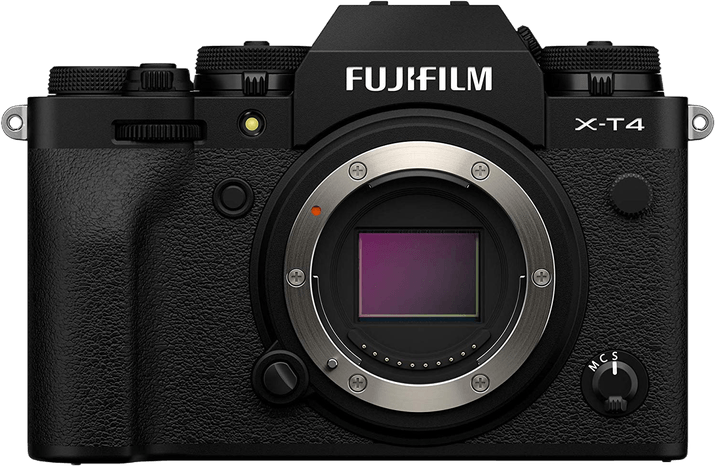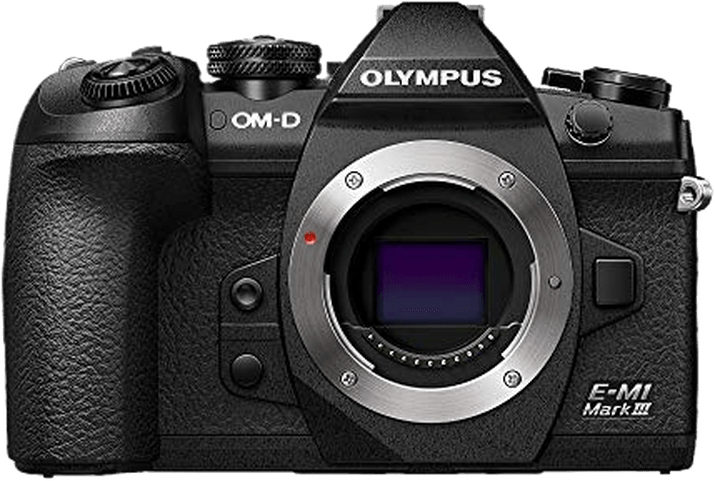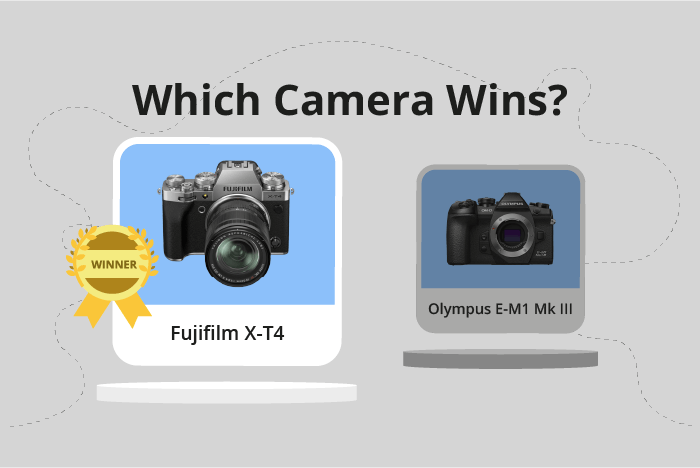Fujifilm X-T4 vs Olympus OM-D E-M1 Mark III Comparison
Fujifilm X-T4

Olympus OM-D E-M1 Mark III

The Fujifilm X-T4 takes the lead with a score of 76/100, while the Olympus OM-D E-M1 Mark III trails slightly behind with a score of 72/100. Both cameras are mirrorless and were introduced in 2020, with the Fujifilm X-T4 announced on February 26th and the Olympus OM-D E-M1 Mark III on February 12th. They share similar dimensions, with the X-T4 measuring 135 x 93 x 84mm and the E-M1 Mark III at 134 x 91 x 69mm.
The Fujifilm X-T4 outperforms its competitor with a lower launch price of $1699, compared to the Olympus OM-D E-M1 Mark III’s $1799. However, the Olympus camera has a slight advantage in weight, being lighter at 580g (1.28lbs) compared to the Fujifilm’s 607g (1.34lbs).
Considering the specifications, the Fujifilm X-T4 proves to be a better option due to its higher score and more affordable price, while the Olympus OM-D E-M1 Mark III may appeal to those who prioritize a lighter camera.
Fujifilm X-T4 vs Olympus OM-D E-M1 Mark III Overview and Optics
The Fujifilm X-T4 outperforms the Olympus OM-D E-M1 Mark III in optics, scoring 73/100 compared to the Olympus’ 68/100. Both cameras share several specifications, including a CMOS sensor type, image stabilisation, and similar processors, the X-Processor 4 in the Fujifilm and the TruePic IX in the Olympus.
The X-T4 surpasses the E-M1 Mark III with its 26-megapixel sensor, APS-C sensor size, and Fujifilm X lens mount, allowing for higher resolution images and better overall image quality. The larger sensor size also contributes to improved low-light performance and dynamic range. Furthermore, the Fujifilm X lens mount offers a wide range of high-quality lenses compatible with the X-T4.
On the other hand, the Olympus OM-D E-M1 Mark III has a faster shooting speed at 60 frames per second compared to the Fujifilm’s 20 frames per second. This makes the Olympus more suitable for action photography or capturing fast-moving subjects. Additionally, the E-M1 Mark III has a DXOMARK score of 80 for its sensor, while the X-T4 does not have a DXOMARK score, as Fujifilm cameras are not scored by DXOMARK.
Despite the Olympus’ faster shooting speed and DXOMARK score, the Fujifilm X-T4’s higher megapixel count, larger sensor size, and superior lens mount make it the better option in terms of optics. The X-T4 is more suitable for photographers prioritising image quality and resolution, while the E-M1 Mark III may be preferable for those focusing on action photography or requiring faster shooting speeds.
Fujifilm X-T4 vs Olympus OM-D E-M1 Mark III Video Performance
The Fujifilm X-T4 outperforms the Olympus OM-D E-M1 Mark III in video capabilities, scoring 91/100 compared to the Olympus’ 83/100. Both cameras share some common video specifications, including a maximum video resolution of 4K and dimensions of 4096 x 2160. Additionally, both cameras have built-in time-lapse functionality, making them suitable for capturing stunning time-lapse videos.
The Fujifilm X-T4 excels with its higher maximum video frame rate of 120fps, allowing for smoother slow-motion footage compared to the Olympus OM-D E-M1 Mark III’s 60fps. This difference in frame rate makes the X-T4 a more versatile choice for videographers who require high-quality slow-motion video capture.
On the other hand, the Olympus OM-D E-M1 Mark III does not offer any significant advantages in video capabilities over the Fujifilm X-T4. With identical maximum video resolution, dimensions, and time-lapse functionality, the Olympus falls short in providing a unique edge in this comparison.
Considering the specifications and scores, the Fujifilm X-T4 is the superior choice for videographers due to its higher video frame rate. This advantage allows for enhanced slow-motion video capture, making it a more versatile option for various video projects. On the contrary, the Olympus OM-D E-M1 Mark III does not offer any distinct advantages in video capabilities, making it less appealing for those seeking optimal video performance.
Fujifilm X-T4 vs Olympus OM-D E-M1 Mark III Features and Benefits
The Fujifilm X-T4 emerges as the winner in the features comparison, scoring 85 out of 100 points, whereas the Olympus OM-D E-M1 Mark III scores slightly lower at 83 points. Both cameras share several specifications, including a 3-inch screen size, touchscreen capabilities, flip screen, absence of GPS, and the presence of WIFI and Bluetooth.
The Fujifilm X-T4 outshines the Olympus OM-D E-M1 Mark III with a better screen resolution of 1,620,000 dots compared to the latter’s 1,037,000 dots. This higher resolution offers a more detailed and clear display, which aids in image composition and reviewing captured shots.
On the other hand, the Olympus OM-D E-M1 Mark III does not have any features that are significantly better than those of the Fujifilm X-T4. Both cameras are quite similar in their offerings, with the Fujifilm X-T4 having a slight edge due to its superior screen resolution.
Taking into account the features comparison, the Fujifilm X-T4 stands out as the better camera. Its higher screen resolution contributes to an enhanced user experience, while the Olympus OM-D E-M1 Mark III does not offer any distinct advantages over its competitor. Although the difference in scores is not drastic, the Fujifilm X-T4’s higher score reflects its better performance in terms of features.
Fujifilm X-T4 vs Olympus OM-D E-M1 Mark III Storage and Battery
The Fujifilm X-T4 wins in the storage and battery comparison with a score of 73/100, while the Olympus OM-D E-M1 Mark III scores 71/100. Both cameras share common specifications, such as having two memory card slots and accepting SD, SDHC, and SDXC memory cards. They also both offer USB charging capabilities.
The X-T4 surpasses the E-M1 Mark III in battery life, providing 500 shots compared to the E-M1 Mark III’s 420 shots. This longer battery life makes the X-T4 more suitable for extended photography sessions. Additionally, the X-T4 is UHS-II compatible for both memory card slots, while the E-M1 Mark III is only UHS-II compatible for one slot.
Despite its lower score, the E-M1 Mark III still performs well in storage and battery aspects. Its battery life is only slightly shorter than the X-T4’s, and it maintains UHS-II compatibility for one of its memory card slots.
Taking these factors into account, the Fujifilm X-T4 has a slight advantage in storage and battery capacity over the Olympus OM-D E-M1 Mark III. While both cameras perform well, the X-T4’s longer battery life and full UHS-II compatibility make it the better choice for storage and battery requirements.
Alternatives to the Fujifilm X-T4 and Olympus OM-D E-M1 Mark III
Are you still undecided about which camera is right for you? Have a look at these popular comparisons that feature the Fujifilm X-T4 or the Olympus OM-D E-M1 Mark III:

